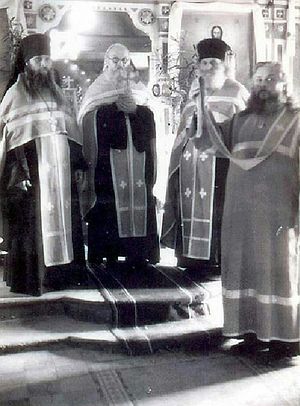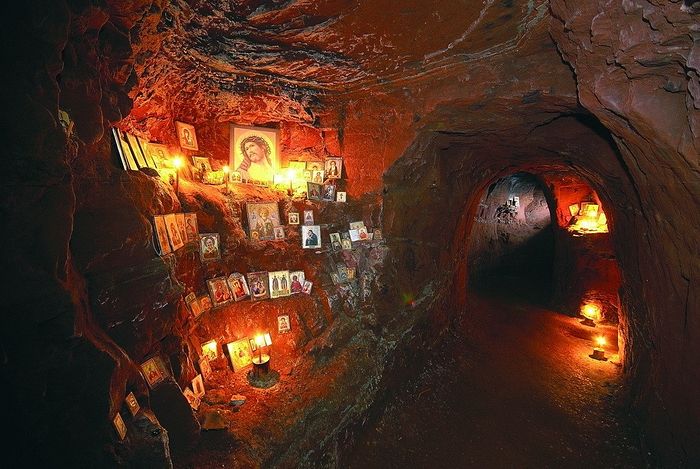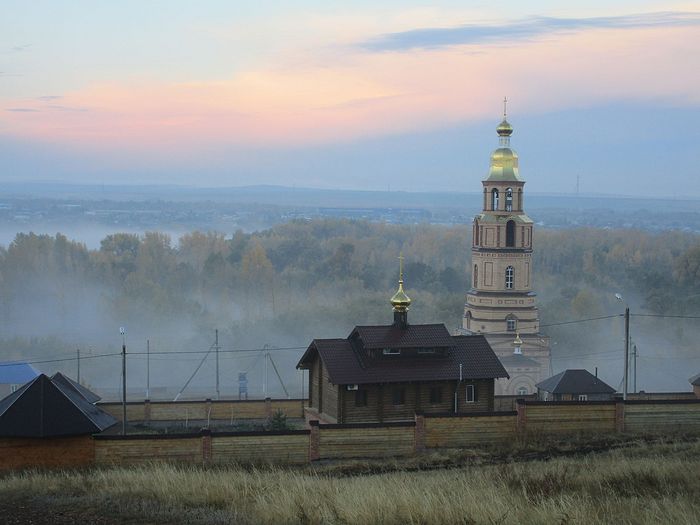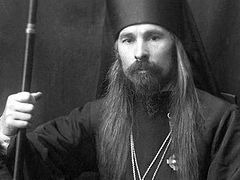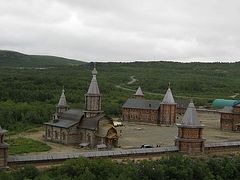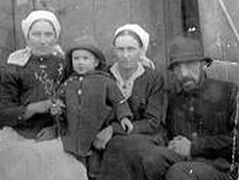Holy Rus’… the eternal and precise name of Orthodox Rus’. Who or what is this holy land of ours? It is holy because of those islands of spirituality and holiness, monasteries, sketes, and God-pleasing people scattered throughout our land. I would like to speak about one such holy place, in the southern Urals on the Orenburg side.
In the village of Nizhneozernoe in the Orenburg Governate there lived the hereditary Cossack Zachary Prokopevich Kartsev. With his wife Pelagia Matveevna, they had seven children, but five of them died in infancy. Only two daughters remained—Matresha and Evdokia—whom their parents greatly loved. They lived piously and tried to please God in all things. They fulfilled the commandments of Christ in action, they honored their parents (they took care of their elderly parents), they spent the whole day in labors, never abandoning prayer and the church of God, and they were merciful and compassionate to others.
But Zachary Petrovich desired to please and serve God more. The Lord saw his desire and by His providence sent him to a new ministry. By agreement with his wife and with the blessing of his elderly mother, by God’s command, as he himself spoke about it, he left for Monashka Mountain near the village of Pokrovka in the Novosergeivsky District and began his new ministry in solitude and in labors. He dug a cave, cleaned the spring near the mountain and began to live and pray, imitating the ancient monastic fathers. The residents of the neighboring village told about how before the arrival of the pious Cossack they saw a fiery pillar on this spot near the mountain.
Soon the devout inhabitants of the surrounding villages, seeing the strong faith, the fervent desire to serve God, and the unwavering firmness and determination of the pious ascetic, wanted to serve God the same way. Thus was gathered the first brotherhood of the future monastery.
How many difficulties and trials the first inhabitants had to overcome. The brothers lived in constant labors and prayers, continuing to dig their caves. The first years were spent in great need because they had no land or farm and lived on the alms of their God-loving peasants. But, having great love for the Lord, faith, and courage, they did not leave this place, continuing their monastic podvig. The Lord, seeing their patience and faith, began to help them through pious people. Merchants and affluent peasants donated to the monastery, each as he was able. Some of the brothers, having arrived at the monastery, donated their plots of land. The Orenburg merchant Anton Nikolaevich Shikhobalov greatly helped.
The newly-appearing holy place quickly blossomed and the number of the brethren increased. They built a wooden home church, a residential building, a bell tower, a prosphora bakery, and a regular bakery. The brothers sowed their own grain, planted an orchard, and organized an apiary.
In 1909, the monastic community received the title of skete by decree of the Holy Synod. Hieromonk Pallady was appointed as the first temporary head of the skete as the most experienced in the monastic life (now glorified in the host of the New Martyrs and Confessors as a monk-martyr). During this time, Zachary Petrovich, having taken the monastic name Zosima, was ordained as a hierodeacon, then as a hieromonk and was appointed as the head of the skete. With God’s help, Batiushka Zosima continued the work on the beautification of the monastery.
In 1911 they finished building the stone church dedicated to St. Nicholas the Wonderworker. During the festive consecration of the church, Batiushka Zosima and the brothers and all those praying were filled with great joy and tearfully thanked God. Who would have thought that on a barren lifeless mountain, where a Cossack hermit labored in the caves, a monastic habitation would blossom sixteen years later?
The brothers prayed and saved their souls by obedience, labors, and mercy. A house for crippled men was built at the monastery. They prayed and labored hard in felting and tanning workshops. Also, even before the construction of the church, a brick factory was built where they made especially strong bricks according to old methods—adding eggs and honey. The buildings made from these bricks are still standing.
In 1916, forty-four monks lived in St. Nicholas Monastery, plus workers. By this time, it was already considered a monastery and continued to develop and grow. But new trials of faith, fidelity to Christ, and bravery awaited the brothers who had embarked upon the monastic path.
The civil war began, with brother against brother. Abbot Zosima called all to peace, urged them to pray for one another and especially for those who suddenly became enemies. Once an enemy from the village of Pokrovka went to see the abbot and asked him to take care of and arrange for three wounded Red Army soldiers in the monastery until their recovery. Batiushka, fulfilling the commandments of Christ in deed and loving his entire flock alike, received the wounded as a father, appointed two helpers for them, and fed them well. When the sick became worse, he sent his horse for a medic. Soon a White Army investigative group of five people appeared in the monastery. Batiushka met them as his spiritual children and sat them down for a common meal. When the Cossacks started asking whether there were any Red Army soldiers in the monastery, Batiushka defended the wounded and did not allow them to kill the defenseless. Another incident also happened in 1918. Four Red Army soldiers were killed and no one wanted to bury them. Then the abbot harnessed his horse and went himself to give burial to the bodies of the deceased, thereby showing mercy to the enemy.
In 1919, the Bolsheviks came to power. Abbot Zosima was immediately arrested and accused of counter-revolutionary activities and of helping the White Army. But the common people interceded for their pastor because many knew and often experienced his care, prayerful help, and fatherly love for them. They began to gather signatures and to petition for the release of Abbot Zosima. At the request of many people and even the village councils of several villages, Batiushka was at first released on bail, without the right to leave the monastery, and later was completely justified.
Having returned to the monastery, Abbot Zosima continued to take care of the monastery, spending time in labors, prayer, and helping people. But Batiushka was open about the future ruin of the monastery. It became known in one case. A certain young man wanted to enter the monastery, but Batiushka Zosima did not bless him: “Go home… You cannot stay here. We will soon be dispersed, and the they will close the monastery, and they will kill us all.”
Batiushka lived a little more than sixty years: His loving heart did not survive the sight of the destruction of faith and piety in the people and the death of human souls. Until the last days, he prayed for the brothers of the monastery and his entire flock.
The orphaned brethren were harassed and persecuted by the new authorities for their faith. At first, they offered the monks to renounce God and join a collective farm. Several left the monastery, others remained, but none of them renounced their faith. The monks continued to live in the monastery, serving God and strengthening one another, like the ancient martyrs. The new authorities didn’t wait long but soon took all the monks remaining in the monastery to Orenburg to the Zauralnaya Grove1 and shot them. Thus, many of the brothers, desiring to serve God in monasticism, were accounted worthy of martyric crowns. And now they joyfully stand before the throne of God and pray for us.
How can we understand by what secret life the soul lived in order to have such courage in the face of death—not just with life’s difficulties, but with death? Not to be fainthearted, but to choose death as better than renunciation of the One, Eternal God. Grant us also, O Lord, by the prayers of the Russian New Martyrs and Confessors of the faith, courage, and truth: not to become despondent, not to lose heart, but with every tiniest step to demonstrate faithfulness to Christ and to fulfill His commandments in deed.
In our time, the monastic life is again reviving on the spot of the St. Nicholas men’s monastery. The holy caves are open again, the entrance to which was filled in by the soviet authorities, and the Divine Liturgy is again celebrated under the vaults of the underground church. Churches and other buildings are being rebuilt. The resurgent new monastery—St. Nicholas’ Convent “of the Holy Caves,” is like a thin, brittle shoot that requires great care now and the participation of all who are not indifferent. And many people, as during the foundation of the monastery on this place, are now trying to help physically and materially, believing that any participation in in the rebirth of the monastery will help the rebirth of their souls. After all, in building beautiful churches, above all we need to take care to build a temple of God in our souls, that the Lord might find a place there for Himself, for He abides only in pure hearts where there is no malice, despondency, or hatred. Grant us, O Lord, pure and humble hearts by the prayers of the Theotokos and the Russian New Martyrs and Confessors.

